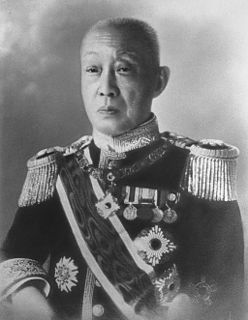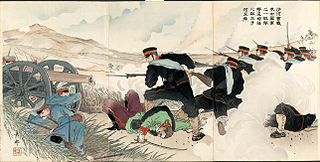 W
WGeneral elections were held in Japan on 1 March 1904. The Rikken Seiyūkai party remained the largest in the House of Representatives, winning 133 of the 379 seats.
 W
WThe Battle of Chemulpo Bay was a naval battle in the Russo-Japanese War (1904–1905), which took place on 9 February 1904, off the coast of present-day Incheon, Korea.
 W
WThe Battle of Liaoyang was the first major land battle of the Russo-Japanese War, on the outskirts of the city of Liaoyang in present-day Liaoning Province, China. The city was of great strategic importance as the major Russian military center for southern Manchuria, and a major population center on the main line on the Russian South Manchurian Railway connecting Port Arthur with Mukden. The city was fortified by the Imperial Russian Army with three lines of fortifications.
 W
WThe Battle of Motien Pass was a minor land battle of the Russo-Japanese War, fought between the Imperial Japanese Army under General Kuroki Tamemoto and the Imperial Russian Army under General Count Fedor Keller over control of a strategic mountain pass on the main road between the coast and Liaoyang, Manchuria on 10 July 1904.
 W
WThe Battle of Nanshan was one of many vicious land battles of the Russo-Japanese War. It took place on 24–26 May 1904 across a two-mile-wide defense line across the narrowest part of the Liáodōng Peninsula, covering the approaches to Port Arthur and on the 116-meter high Nanshan Hill, the present-day Jinzhou District, north of the city center of Dalian, Liaoning, China.
 W
WThe Battle of Port Arthur of 8–9 February 1904 marked the commencement of the Russo-Japanese War. It began with a surprise night attack by a squadron of Japanese destroyers on the neutral Russian fleet anchored at Port Arthur, Manchuria, and continued with an engagement the following morning; further skirmishing off Port Arthur would continue until May 1904. The attack ended inconclusively, though the war resulted in a decisive Japanese victory.
 W
WThe Battle of Tashihchiao was a land engagement fought on 24–25 July 1904, during the Imperial Japanese Army's advance toward Liaoyang in first stage of the Russo-Japanese War. Tashihchiao is located about 25 kilometres (16 mi) southwest of the city of Haicheng, in present-day Liaoning Province, China. The town of Tashihchiao was of strategic importance in the Russo-Japanese War, as it was a railroad junction between the main line on the Russian South Manchurian Railway and a spur which led to the old treaty port of Yingkou (Newchwang). Control of both was essential for further advances by Japanese forces towards Liaoyang and Mukden.
 W
WThe Battle of Te-li-ssu, also called Battle of Wafangou after the nearby railway station, was a land battle of the Russo-Japanese War. It was fought at a hamlet some 80 mi (130 km) north of Port Arthur, Manchuria. The hamlet is known today as Delisi, and is located just north of Wafangdian, Liaoning Province, China. It was fought on 14–15 June 1904 between the Japanese Second Army under General Oku Yasukata and the Russian First Siberian Army Corps under Lieutenant General Georgii Stackelberg.
 W
WThe Battle of the Yalu River lasted from 30 April to 1 May 1904, and was the first major land battle during the Russo-Japanese War. It was fought near Wiju on the lower reaches of the Yalu River, on the border between Korea and China.
 W
WThe naval Battle off Ulsan, also known as the Battle of the Japanese Sea or Battle of the Korean Strait, took place on 14 August 1904 between cruiser squadrons of the Imperial Russian Navy and the Imperial Japanese Navy during the Russo-Japanese War, four days after the Battle of the Yellow Sea.
 W
WThe Hitachi Maru Incident was a maritime incident which occurred during the Russo-Japanese War of 1904–1905, in which three Japanese transports were sunk in a Russian commerce raiding sortie by a Vladivostok-based armored cruiser squadron of the Imperial Russian Navy.
 W
WThe Russo-Japanese War was fought during 1904 and 1905 between the Russian Empire and the Empire of Japan over rival imperial ambitions in Manchuria and Korea. The major theatres of operations were the Liaodong Peninsula and Mukden in Southern Manchuria and the seas around Korea, Japan and the Yellow Sea.
 W
WThe Battle of Shaho was the second large-scale land battle of the Russo-Japanese War fought along a 37-mile (60 km) front centered at the Shaho River along the Mukden–Port Arthur spur of the China Far East Railway north of Liaoyang, Manchuria.
 W
WThe Siege of Port Arthur was the longest and most violent land battle of the Russo-Japanese War.
 W
WThe Battle of the Yellow Sea was a major naval battle of the Russo-Japanese War, fought on 10 August 1904. In the Russian Navy, it was referred to as the Battle of 10 August. The battle foiled an attempt by the Russian fleet at Port Arthur to break out and form up with the Vladivostok squadron, forcing them to return to port. Four days later, the Battle off Ulsan similarly ended the Vladivostok group's sortie, forcing both fleets to remain at anchor.